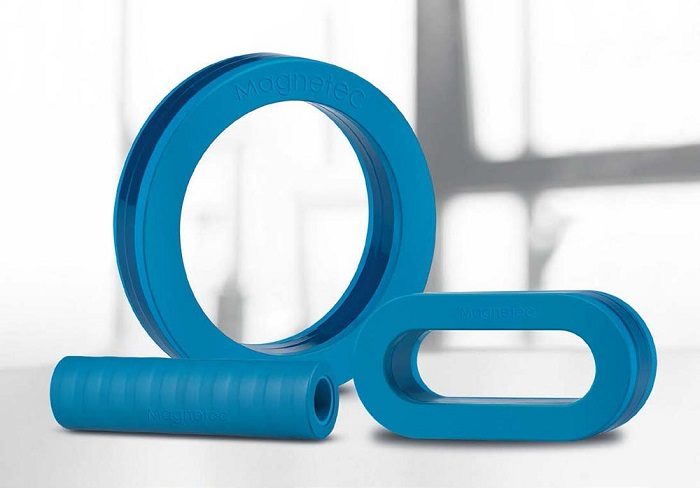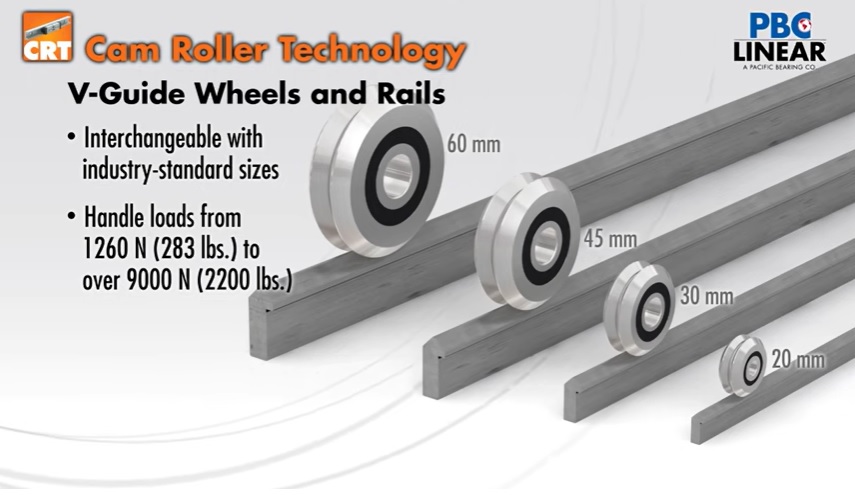Extending Inverter-Motor Systems Service Life
Protecting electric drives from erosion caused by motor-bearing currents

Current-compensated CoolBlue toroidal cores made of the nanocrystalline material Nanoperm from Magnetec have proven to be effective protection against conducted interference and its consequences. With Nanoperm Line Absorbers NaLA from Magnetec, symmetrical interference currents can also be significantly suppressed. (Courtesy of Magnetec)
More energy efficiency, higher performance and better controllability are the main reasons why more electric drive systems are being operated with frequency converters. However, these devices can cause high-frequency, asymmetrical interference currents, which, as a current passage through the output and fan-side bearings, can cause damage and premature failure.
Current-compensated CoolBlue toroidal cores made of Magnetec’s nanocrystalline material Nanoperm have proven to be effective protection against such conducted interference and its consequences. In addition, the Nanoperm Line Absorbers NaLA can also be used to significantly suppress symmetrical interference currents.
Together, these technologies offer optimal protection of inverter-motor systems against motor bearing damage caused by interference current, thus significantly increasing the availability and service life of electric drives in complex industrial applications including chemical, paper, rail, shipping, logistics, or energy generation with solar and wind power plants.
 Conducted interference results from over voltages caused by switching operations in the frequency converter (VFD). As asymmetrical interference currents in the range from about 300 kHz to 400 kHz, they flow from there to the motor.
Conducted interference results from over voltages caused by switching operations in the frequency converter (VFD). As asymmetrical interference currents in the range from about 300 kHz to 400 kHz, they flow from there to the motor. Current Passage Causes Electrical Erosion in Gearbox Bearings
The wiring of converter-motor systems is very often carried out exclusively with shielded three-phase cables. Although these can shield radiated interference of the three-phase AC voltage from other systems when connected in accordance with EMC, they do not completely protect against conducted interference. These result from over voltages caused by switching operations in the frequency converter. As asymmetrical interference currents in the range from about 300 kHz to 400 kHz, they flow from the frequency converter to the motor. Before they start their return journey via ground and earth, the interference currents in the motor from the stator and rotor are coupled via—almost like a capacitor. From there, they flow in the contact zone of the rotor and housing through the output- and fan-side bearings. This results in an electrical discharge from the inner ring via the balls to the outer ring, the energy of which leads to sparks and the formation of electric arcs. The high punctual thermal energy released in this process melts the bearing treads at the transition point. As a result, microcraters and loose particles of molten material are formed there. These delicate consequences of electrical erosion become visible under the microscope—without a microscope, a matte, greyish tread indicates the consequences of the passage of electricity. In further operation, washboard- or zebra-like, gray corrugations can be seen on the treads, which are the result of the melted out microcraters and particles. The course of damage in the gearbox is accompanied by the fact that the heat generated by sparks destroys the lubricant in the rolling bearing. The base oil burns, additives char—the lubricant decomposes rapidly. This turns dark—an unmistakable indicator of rapid aging, poor lubricity, and shortened service life.
The result is a premature failure of the gearbox—often years earlier than in the case of purely mechanical wear. With CoolBlue toroidal cores and Nanoperm Line Absorbers NaLA , common-mode and push-pull interference currents can be compensated and the effects on the motor bearings can be avoided.
CoolBlue: An Efficient Compensation Against Interference Currents for Small and Large System Powers
Magnetec’s CoolBlue toroidal cores have been specially developed to prevent the transmission of conducted interference in inverter motor systems with system outputs ranging from one kilowatt to the high megawatt range. They absorb common-mode interference currents caused by the frequency converters, which, in contrast to the push-pull currents, are not fed back via the cables, but seek their way back through the motor and its bearings via a path with low electrical resistance. To absorb the interference, the CoolBlue toroidal cores are placed as close as possible to the frequency converter in a nonshielded location, and all three phases are passed through the ring. For the common-mode current, the toroidal cores represent both an inductance and an impedance. The current flowing through the cable creates a magnetic field that is attenuated by the toroidal cores. Their size depends on the system performance, so that the size and number of the CoolBlue toroidal cores are dimensioned accordingly via a selection table so that they can absorb the fault in the best possible way and do not overdrive beforehand. The cores, which can be selected or dimensioned in size, diameter and shape, are controlled and absorb the interference, converting the absorbed energy of the common-mode interference currents into heat. In this way, the ball bearings are effectively protected against electrical erosion—and permanently without any maintenance or repair effort for the toroidal strip cores.
 When electrical discharge of interference currents, their energy generates a breakdown and the formation of electric arcs. The result is melted out microcraters and particles that can be seen on the treads as washboard- or zebra-like, gray corrugations.
When electrical discharge of interference currents, their energy generates a breakdown and the formation of electric arcs. The result is melted out microcraters and particles that can be seen on the treads as washboard- or zebra-like, gray corrugations.
NaLA Protects Against Symmetrical Currents
Nanoperm Line Absorbers, NaLAs, complement CoolBlue toroidal band cores in inverter motor systems. Although they do not primarily reduce the common-mode interference that is responsible for the destruction of the ball bearings, they improve the general EMC properties in the system and thus also protect the surrounding devices. In addition, they also reduce conducted interference towards the grid. CoolBlue and NaLA have proven to be an economical solution for the protection of industrial inverter motor systems due to their particularly absorption behavior in common-mode and push-pull interference currents, their simple installation, and their maintenance-free operation. Due to their wear-free and maintenance-free broadband filter effect, they also offer significant advantages over possible alternatives such as grounding brushes that wear out during operation, expensive and only limited effectiveness of current-insulated bearings, inhospitable hybrid bearings with ceramic balls or large and expensive all-pole sinusoidal filters.
 The Magnetec CoolBlue and NaLA cores made of nanocrystalline material Nanoperm are used to reduce damaging motor bearing currents in inverter—motor systems. This method significantly increases the service life of the motor bearings and thus reduces maintenance costs and standstill periods.
The Magnetec CoolBlue and NaLA cores made of nanocrystalline material Nanoperm are used to reduce damaging motor bearing currents in inverter—motor systems. This method significantly increases the service life of the motor bearings and thus reduces maintenance costs and standstill periods.
Nanoperm—Nanocrystalline Iron-Based Alloy with Special Soft Magnetic Properties
Nanopermium is a rapidly solidified iron-based alloy that changes from an amorphous to a nanocrystalline structure with grain sizes of 10 nm after annealing. This, in turn, in combination with a significantly higher lithium content than hard magnetic ferrite materials with a crystal lattice structure, is the cause of the extraordinarily good soft magnetic properties of Nanoperm, which can also be adjusted in wide ranges by heat treatment under the influence of external magnetic fields. Nanoperm is produced in a special process as a continuous strip material with a thickness of 16 μm to 20 μm and, in contrast to ferritic materials, achieves a broadband interference suppression effect up to high frequency ranges. It is extremely heat-resistant at > 120°C and remains stable in its inductance over the entire specified operating temperature range of -40°C to +200°C and its Curie temperature of around 600°C. The permeability is up to a factor of 10 and the saturation up to a factor of 3 is higher than that of ferrite materials. The Nanoperm tape can be processed into any light and compact size and design. Nanoperm LM toroidal cores are particularly used in applications with a high proportion of asymmetrical interference currents (e.g., frequency converters), for example CoolBlue toroidal cores to reduce harmful motor bearing currents. Nanoperm LC toroidal cores are cost-effective cores to produce Magnetec’s single- or multi-phase current-compensated EMC chokes. They also offer an excellent alternative to existing ferrite-based solutions. The soft magnetic cores of the Nanoperm MR series are mechanically compatible with common ferrtite designs and can replace ferrites from a size of 56 mm 1:1 in interference suppression applications.







